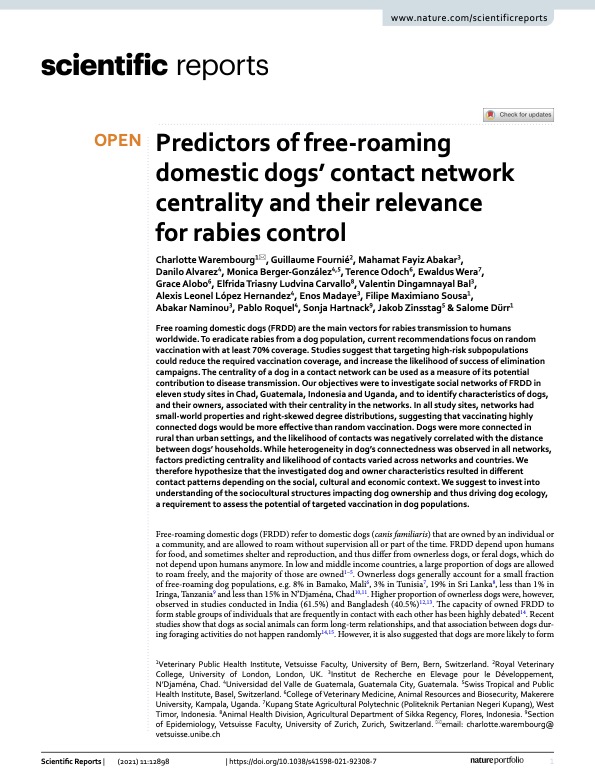C Warembourg
Predictors of free-roaming domestic dogs' contact network centrality and their relevance for rabies control
Warembourg, C; Fournie, G; Abakar, MF; Alvarez, D; Berger-Gonzalez, M; Odoch, T; Wera, E; Alobo, G; Carvallo, ETL; Bal, VD; Hernandez, ALL; Madaye, E; Sousa, FM; Naminou, A; Roquel, P; Hartnack, S; Zinsstag, J; Durr, S
Authors
G Fournie
MF Abakar
D Alvarez
M Berger-Gonzalez
T Odoch
E Wera
G Alobo
ETL Carvallo
VD Bal
ALL Hernandez
E Madaye
FM Sousa
A Naminou
P Roquel
S Hartnack
J Zinsstag
S Durr
Abstract
Free roaming domestic dogs (FRDD) are the main vectors for rabies transmission to humans worldwide. To eradicate rabies from a dog population, current recommendations focus on random vaccination with at least 70% coverage. Studies suggest that targeting high-risk subpopulations could reduce the required vaccination coverage, and increase the likelihood of success of elimination campaigns. The centrality of a dog in a contact network can be used as a measure of its potential contribution to disease transmission. Our objectives were to investigate social networks of FRDD in eleven study sites in Chad, Guatemala, Indonesia and Uganda, and to identify characteristics of dogs, and their owners, associated with their centrality in the networks. In all study sites, networks had small-world properties and right-skewed degree distributions, suggesting that vaccinating highly connected dogs would be more effective than random vaccination. Dogs were more connected in rural than urban settings, and the likelihood of contacts was negatively correlated with the distance between dogs' households. While heterogeneity in dog's connectedness was observed in all networks, factors predicting centrality and likelihood of contacts varied across networks and countries. We therefore hypothesize that the investigated dog and owner characteristics resulted in different contact patterns depending on the social, cultural and economic context. We suggest to invest into understanding of the sociocultural structures impacting dog ownership and thus driving dog ecology, a requirement to assess the potential of targeted vaccination in dog populations.
Citation
Warembourg, C., Fournie, G., Abakar, M., Alvarez, D., Berger-Gonzalez, M., Odoch, T., Wera, E., Alobo, G., Carvallo, E., Bal, V., Hernandez, A., Madaye, E., Sousa, F., Naminou, A., Roquel, P., Hartnack, S., Zinsstag, J., & Durr, S. (2021). Predictors of free-roaming domestic dogs' contact network centrality and their relevance for rabies control. Scientific Reports, 11(1), https://doi.org/10.1038/s41598-021-92308-7
| Journal Article Type | Article |
|---|---|
| Acceptance Date | Jun 4, 2021 |
| Publication Date | 2021 |
| Deposit Date | Jan 7, 2022 |
| Publicly Available Date | Jan 7, 2022 |
| Journal | Scientific Reports |
| Electronic ISSN | 2045-2322 |
| Publisher | Nature Research |
| Peer Reviewed | Peer Reviewed |
| Volume | 11 |
| Issue | 1 |
| DOI | https://doi.org/10.1038/s41598-021-92308-7 |
| Keywords | VACCINATION CAMPAIGN; MASS VACCINATION; PUBLIC-HEALTH; CANINE RABIES; RURAL-AREAS; URBAN AREAS; POPULATION; BEHAVIOR; DYNAMICS; COVERAGE |
| Public URL | https://rvc-repository.worktribe.com/output/1554811 |
Files
OA
(173 Kb)
Image
Publisher Licence URL
http://creativecommons.org/licenses/by/4.0/
Downloadable Citations
About RVC Repository
Administrator e-mail: publicationsrepos@rvc.ac.uk
This application uses the following open-source libraries:
SheetJS Community Edition
Apache License Version 2.0 (http://www.apache.org/licenses/)
PDF.js
Apache License Version 2.0 (http://www.apache.org/licenses/)
Font Awesome
SIL OFL 1.1 (http://scripts.sil.org/OFL)
MIT License (http://opensource.org/licenses/mit-license.html)
CC BY 3.0 ( http://creativecommons.org/licenses/by/3.0/)
Powered by Worktribe © 2025
Advanced Search

